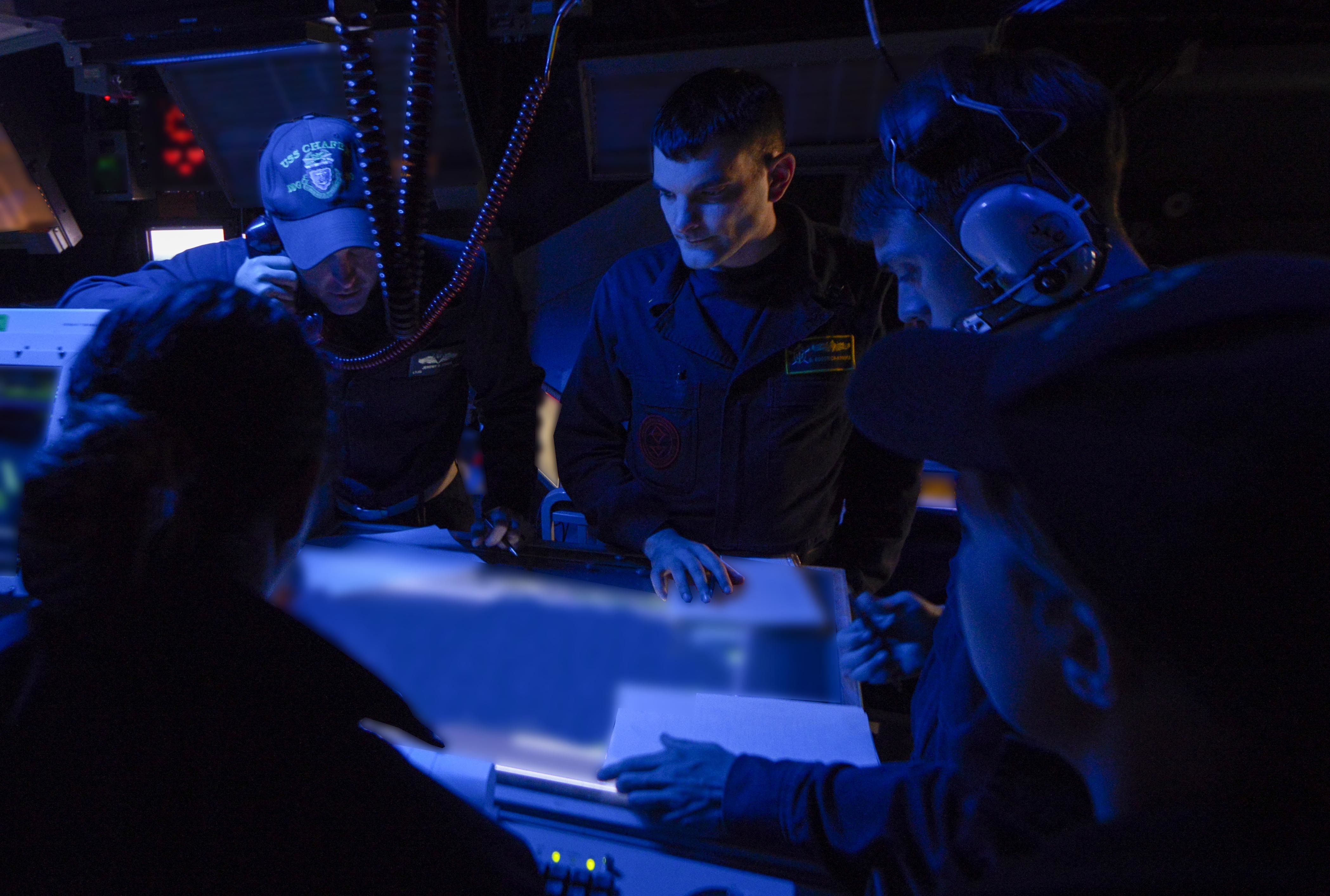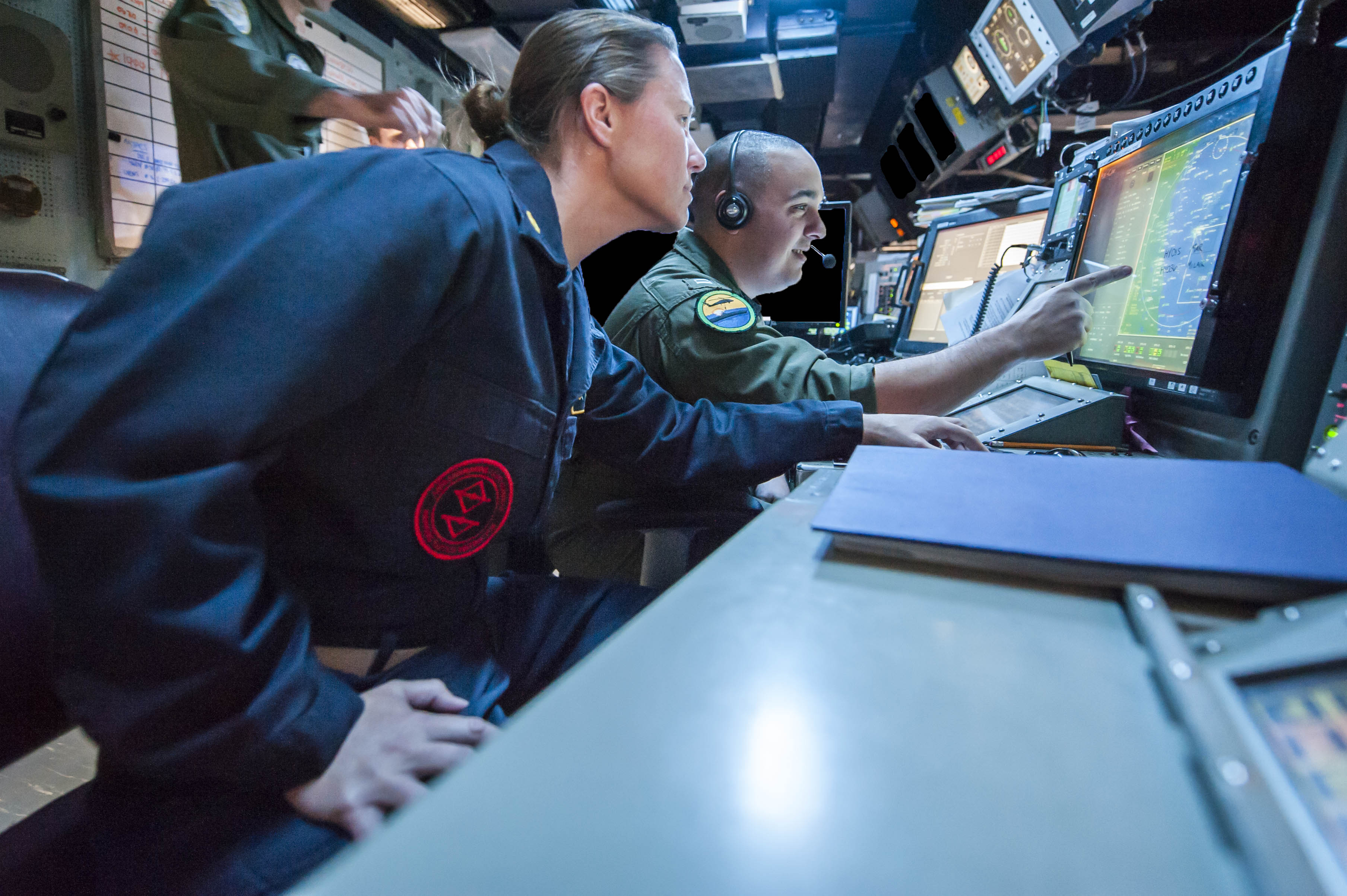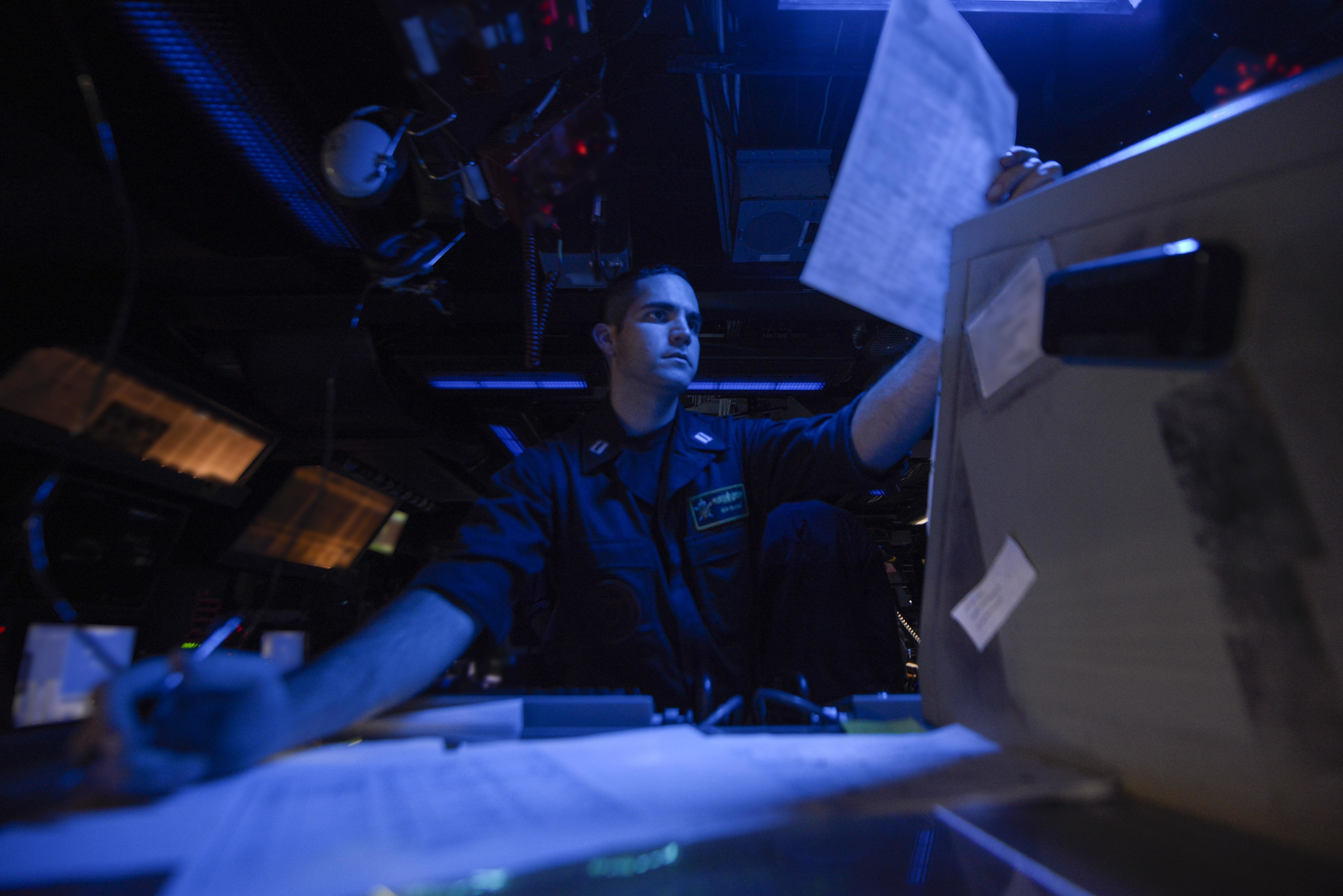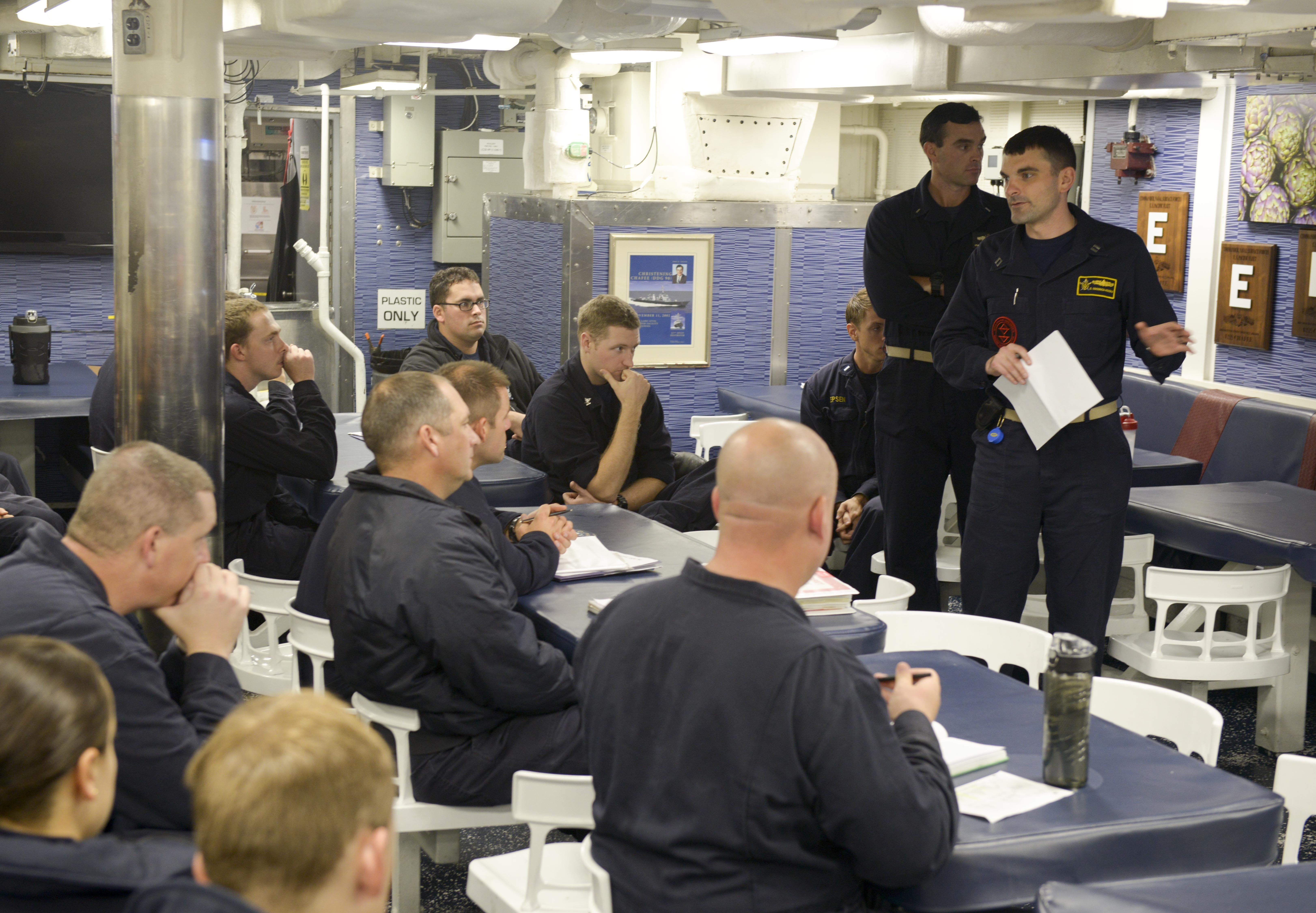
This post has been updated to include additional information from the Naval Surface and Mine Warfighting Development Center.
When Lt. Cmdr. Katie Whitman deployed on USS Mobile Bay (CG-53) five years ago, she was expected to support the cruiser in its air defense commander role but wasn’t guaranteed much individual training for that mission.
As it happened, leadership in the John C. Stennis Carrier Strike Group was “forward-leaning” when it came to pursuing additional pre-deployment training opportunities, she told USNI News, but another lieutenant on another cruiser may have deployed overseas without much knowledge of advanced tactics for that mission set or practice handling complex air warfare scenarios.
“You leave your basic phase and you’ve got two qualified watch teams, a blue team and a gold team, and you’re good at doing basic stuff. But cruisers a lot of times are air defense commanders as well. Nobody really came to me and said, ‘Katie, here’s some help on how to be an air defense commander,'” she said.
Now the lead planner for the Surface Warfare Advanced Tactical Training (SWATT) at the Naval Surface and Mine Warfighting Development Center (SMWDC), Whitman is in a position to create standardized training for air defense commanders, sea combat commanders and surface ship crews, to give them a proficiency she wasn’t guaranteed to gain ahead of deploying to increasingly complex theaters and facing more advanced threats.

SWATT Origins
SWATT is a new surface ship training event that fits between single-ship basic training and the Composite Training Unit Exercise (COMPTUEX), where the entire carrier strike group and its air wing operate together in complex at-sea scenarios. It is meant to both acquaint the surface ship crews with one another and expose the crews to more advanced tactics.
SMWDC’s deputy commander, Capt. Chris Barnes, served as the chief of staff of Carrier Strike Group 15, the certifying organizations for West Coast carrier strike groups, prior to joining SMWDC. From his time in that job, he can attest to the disparity between the aviators – who have long had the Naval Aviation Warfighting Development Center, or Top Gun, for advanced tactics training – and the surface warfare officers when they show up for COMPTUEX.
SWATT, he told USNI News in a Feb. 16 phone interview, is meant to address “the difference in the readiness of the surface warfare ships showing up at COMPTUEX as compared to, say, the aviators who were showing up to COMPTUEX.”
“One of the things they do from an aviation perspective is, initially each squadron shows up at Fallon – so whether it’s an E-2 squadron, an F-18 squadron or whatever it may be, they show up as a squadron at Fallon during their basic phase and their transition to the integrated phase, doing squadron stuff – flying together, training together, you name it,” Barnes explained.
“So they start integrating pretty early. Then, prior to the actual start of the COMPTUEX, the entire air wing gets together, so all the F-18 squadrons, all the E-2 squadrons, all the helicopter squadrons, you name it, they all get together and do a workup together to integrate. The surface warfare community, prior to SWATT, never got that. So what did that mean? So when the air wing showed up to COMPTUEX, they were comfortable working with each other and they had already done it at Fallon.”
“From a surface warfare perspective, you say, well maybe if we got our folks together, get the ships together with the [destroyer squadron] commander, the air defense commander, got them underway and did some integrated operations together, then we could better prepare for the high-end fight that’s going to occur in COMPTUEX. So that’s what we did,” he continued.
“We built this thing called Surface Warfare Advanced Tactical Training, and we got together with Strike Group 15 and Strike Group 4 and said, hey, what do you think we should be doing for these guys during SWATT to help them be prepared for COMPTUEX? And they gave us a laundry list of things to do; we already had our ideas – surprise surprise, they were almost identical, and so that’s how we built SWATT, to be able to integrate early, to do basics in tactics and then get to a more advanced level of tactics so that when they show up to COMPTUEX they’re ready for a high-end fight when they get there.”
Two other barriers to success were also addressed by SWATT. First, he said, the surface ships at times faced communications issues during the first few days of COMPTUEX due to not having operated together in advance – whereas the planes within each squadron and within the air wing had already flown together and worked out any communications and networking kinks. The addition of SWATT allows these issues to be dealt with earlier in the training process so as not to take valuable time away from COMPTUEX.
And secondly, churn within the surface warfare development community had led to a pause in reviewing and updating tactics memos and publications. Barnes said “we went about seven, eight, nine years without really doing a lot of tactical development,” and when he commanded a ship “I wasn’t 100-percent sure that the tactics that were out there were current enough, that I didn’t have to take that and then modify it for the fight that I thought needed to be done.” SMWDC has gone through all the memos to update them as needed to reflect new Navy capabilities or emerging threats – revising or writing 23 tactical publications in 2016 alone, a 360-percent increase over the past six years – and ship commanders can now have more confidence that surface warfare training reflects modern best practices.
What Is SWATT?
SMWDC ultimately designed a four-week advanced phase of pre-deployment training, to be inserted in after basic phase and before integrated training with the whole strike group. SMWDC has conducted several SWATT-like events and one full-blown SWATT for the Nimitz Carrier Strike Group, and beginning in 2018 all deploying carrier strike groups and amphibious ready groups on both the East and West Coast will be required to go through SWATT before COMPTUEX and the final certification exercise.
Whitman, the SWATT lead planner, told USNI News in a Feb. 21 interview at the WEST conference in San Diego that the Nimitz CSG training event proved out two main features of SWATT: a planning, briefing, execution and debriefing (PBED) process to train watch standers, and a crawl, walk, run approach to getting the crews to succeed in increasingly complex scenarios over a short amount of time.
The Nimitz CSG SWATT began with a week of training for the air defense commander and the DESRON commander staffs, which is not included in the basic training phase, followed by five days of in-port training for all the ships’ full crews. Next came 16 days at sea, which included two weeks of more than 100 serial standalone events, culminating in a “final battle problem” for the strike group as a whole to tackle.
Throughout the two weeks of serial events, the ships would exercise from about 8 a.m. to 4 p.m., and in the evenings the crews would go through a debriefing process – much like football teams going over film after a game, to compare how their plays were drawn to how the team actually executed those plays.
“We invested a lot of thought into the process of how we get replays to ships at sea, because that’s typically not something that’s done,” Whitman said, likening the old training method to the SATs, where a student finds out a score afterwards but never has a chance to see what specific questions he or she got right and wrong.

Under the PBED construct, the Warfare Tactics Instructors at SMWDC would sit down with the watch team and others involved in any given mission to go over the plan ahead of time. During the exercise, the WTIs would collect data, and two to four hours after the mission the WTIs would sit down with the 15 to 20 operators and go over what happened during the exercise.
Whitman called the replays “a bird’s eye view of the event: you have the ground truth, positions from ships, and you upload the combat systems’ data on top of that, so basically it’s a check on, was what you thought you saw actually what you saw? And then we can also record communications as well, so you can hear the internal comms circuit for the ship. And so you replay that entire event, with the entire watch team there in the debrief, and you get the opportunity basically to walk through in real-time: alright, at this time this watchstander did X. Let’s pause the tape; what were you thinking at that time? So it really engages the watchstanders at a much better level than we ever have before, and because they know they’ll be held accountable to that – at the first debrief people are like, whoa, I didn’t know this was going to happen, but then the next scenario they’re like, man, I’m going to fix those mistakes, I know what my job is now, I’m thinking about it, I’m going to be asked to defend my actions in some way. So we found that watch teams got it faster, learned faster.”
Additionally, the commanding officer and executive officer of the ships participated in many of the debriefs, she said, which allowed a rare opportunity for them to weigh in on how they would tackle a specific tactical movement.
“That’s awesome, right? You have a junior watchstander who is listening to the captain talk about what he’s thinking and what he wants, so you get a lot of commander’s intent and guidance, and the ship learns much faster what the captain’s thinking and what he’s interested in,” Whitman said.
The at-sea exercises during the Nimitz SWATT covered air warfare, surface warfare, anti-submarine warfare and electromagnetic maneuver warfare, she said. The two cruisers and four destroyers were divided up into two three-ship Surface Action Groups, one of which included the air defense commander and the other including the DESRON staff as the sea combat commander.
For air defense, the SAGs faced different threat sets and in the basic phase may have only had to track and identify the threat, whereas in the intermediate phase the threat may have been more kinetic and in the advanced phase the SAG would have had to engage the threat. For surface warfare, the two SAGs faced off in a blue-on-blue exercise where they each leveraged their own capabilities but were at times restricted in their use of helicopters’ offboard sensors, or forced to operate in more complex geopolitical scenarios, Whitman said. For anti-submarine warfare, the SAGs were able to work with a Chilean diesel submarine – which had the additional benefit of partnership-building with the Chilean navy – and moved from a basic submarine search to protecting a stationary high-value target to protecting a moving high-value target from the submarine.
For the electromagnetic maneuver warfare exercises, sailors from the Navy Information Operations Command and the Fleet Electronic Warfare Center came aboard the ship to help the crews think through their emissions while operating at sea. Whitman explained that during the basic phase of training the crews are just trying to successfully complete their missions, and then during COMPTUEX they’re asked to complete a task in a low- or no-emissions environment. That “data diet” seriously complicates the task at hand and the surface warfare officers have often never faced that situation before, so the inclusion of EMW during SWATT will help increase awareness and proficiency for the crews ahead of COMPTUEX.
Finally, the SWATT ended with a five-ship strike group – all four destroyers and a cruiser serving as the air defense commander – facing off against the second destroyer and two Canadian Halifax-class frigates in a two-day scenario meant to test the ship crews in all warfare areas they had learned.

Lt. Damon Goodrich-Houska, a WTI who specializes in anti-submarine and surface warfare and who was underway aboard USS Chafee (DDG-90) during the Nimitz SWATT, told USNI News that SWATT was particularly important for the anti-sub warfare officers who may have learned how to look for a single sub on a lone destroyer but who weren’t trained in integrating as a larger group, which is required of them during COMPTUEX. He added that the PBED process is particularly helpful here – because sub hunting involves so much math and virtually no visual confirmation, it isn’t helpful to know that the crew didn’t find the submarine, but overlaying what they calculated with the submarine’s actual location can help them better identify where they went wrong and do better next time.
Lt. Ben Olivas, an integrated air and missile defense WTI who also worked aboard Chafee during the SWATT, said air warfare is a whole different animal – compared to the meticulous planning and calculations of surface and anti-submarine warfare, air warfare happens quickly and requires split-second decision-making, sometimes with incomplete information to work with.
“When you’re just coming out of the basic phase … [the crews] may not necessarily have all those procedures in their head like muscle memory, so the great thing about SWATT is it takes all these people who are going to be standing watches underway and you’re giving them those repetitions, you’re giving them the ability to demonstrate what they know.”
Barnes, the SMWDC deputy commander, said the WTIs will continue to host SWATT-like events this year and will do a full SWATT for a deploying amphibious ready group, ahead of the formal inclusion of SWATT into the Fleet Training Continuum next year.
Despite budget pressures in the operations and maintenance account, Barnes said SWATT “is definitely being made a priority.” Positive feedback from sailors who have undergone the training so far is “helping us not feel the pressures of whatever budgeting constraints are out there,” he said.
Limited O&M funds may hinder the Navy from flying airplanes specifically to serve as opposing forces during SWATT events, and U.S. Navy submarines that are already in great demand around the globe may not be available to participate, but the Chilean and Canadian navies’ participation in the Nimitz SWATT may prove to be a helpful model to overcome budget challenges and to increase partner-building opportunities at the same time.





